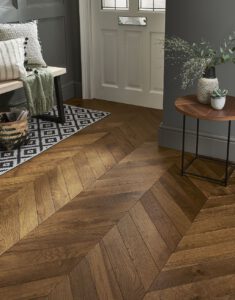When choosing the right flooring for your home, there are several factors to consider. The main living areas of your home will affect the type of flooring you should choose. The kitchen and bathrooms are often the centers of the home, so you’ll want to choose something that will stand up to daily use while still being easy to clean. Fortunately, there are many different types of hardwood flooring, and each offers its own unique benefits. Click Here to learn about some of your options.

Linoleum flooring was first manufactured in the mid-1800s by Frederick Walton and was very popular until the mid-1930s, when decorative linoleum was developed. In the states, dark asphalt sheet materials were introduced in the 1920s, and they were made from asbestos fiber and mineral fillers. Within a decade, light-colored resins that were free of asphalt were developed. Although the term “linoleum” is still commonly used in the states, it refers to a different type of flooring material.
Another type of flooring that is extremely easy to install is modular carpet tiles. These tiles are reusable and can be easily used to cover hard-to-cover areas. Additionally, they can be mixed and matched to create patterns and effects. However, it is important to remember that modular carpet tiles require careful installation to avoid wonky edges. However, if you’re not experienced in laying carpet tiles, you should consider hiring a professional. In addition to this, you’ll find that modular carpet tiles are very inexpensive.
Aside from the obvious benefits of installing laminate flooring in a home, you’ll also need to consider the environmental benefits of each type of flooring. While vinyl is 100% synthetic, linoleum is made from a mix of wood dust, pine rosin, and linseed oil. Linoleum isn’t as durable as vinyl, but it’s more environmentally friendly than vinyl and is ideal for a number of applications.
Natural stone is a popular choice for flooring. While it requires special care during installation, it can be used in any room. It is a porous material that absorbs the ambient temperature of a room and doesn’t feel cold like ceramic tiles. Furthermore, it won’t harbor dust mites or pet hair, making it an excellent choice for allergy sufferers. Unlike ceramic tiles, stone flooring can be installed in any room of the home, but it’s best for rooms that don’t get too hot.
Before you install new flooring, you should take steps to prepare the surface beneath it. In most cases, you’ll need to install a layer of underlayment. This may be rosin paper or fiber padding. While the additional steps may take longer than installing a new floor, the benefits will outweigh the savings in the short run. Adding underlayment ensures that your floors will be durable and beautiful for years to come. When you install new flooring, it’s important to have it installed by a professional.
Your flooring should complement the look of the room you’re trying to update. Choose something that matches the color scheme of the room and your budget. You may want to go with tile if you’re looking for a modern, open look for the kitchen and bathroom, but stained wood with a statement rug might be a more stylish option for your dining room. When selecting your flooring, keep in mind that different materials have different visual effects. For example, vinyl tile will make a room look cheap, while solid wood flooring can add a luxury look.
Ceramic tile is a classic choice for high-traffic areas. It has been proven to be scratch and dent resistant, and a variety of styles can match any decor. From small format hex tiles to four-foot faux reclaimed-ash planks, porcelain tile can be a timeless option for your home. It’s easy to maintain and will last a lifetime. So, whether you’re looking for a rustic look or a modern design, ceramic tile is a great choice for your home.
Engineered wood is another popular alternative to solid hardwood. This flooring option has multiple layers of ply plank with a top layer of genuine hardwood. It’s much more stable than solid wood and can be installed over an existing floor or concrete subfloor. However, engineered wood is not as durable as solid wood, so you may need to refinish it several times to keep it looking new. Engineered wood is also more affordable than solid wood, so it’s a great choice if you have a basement or are concerned about moisture damage.